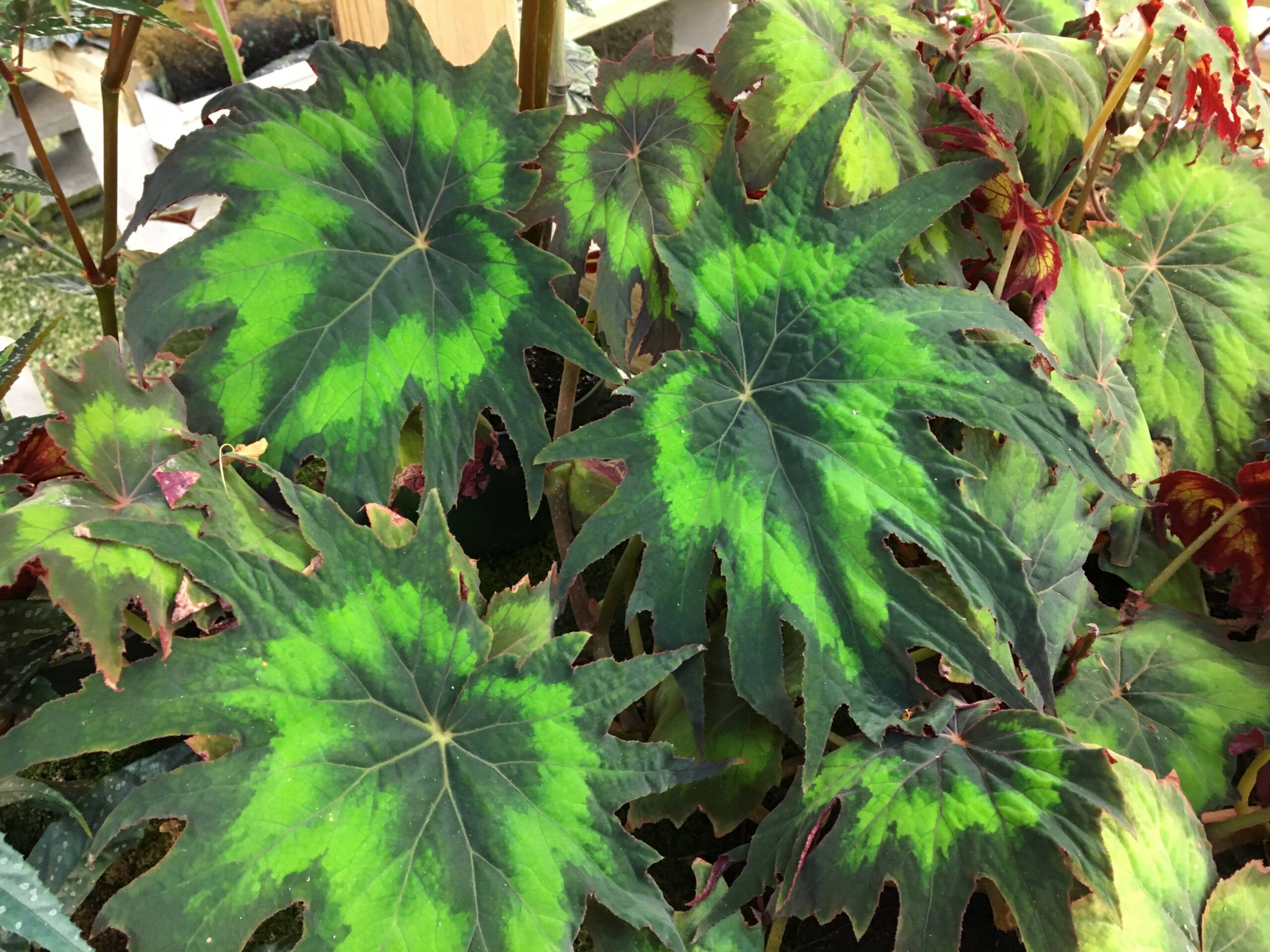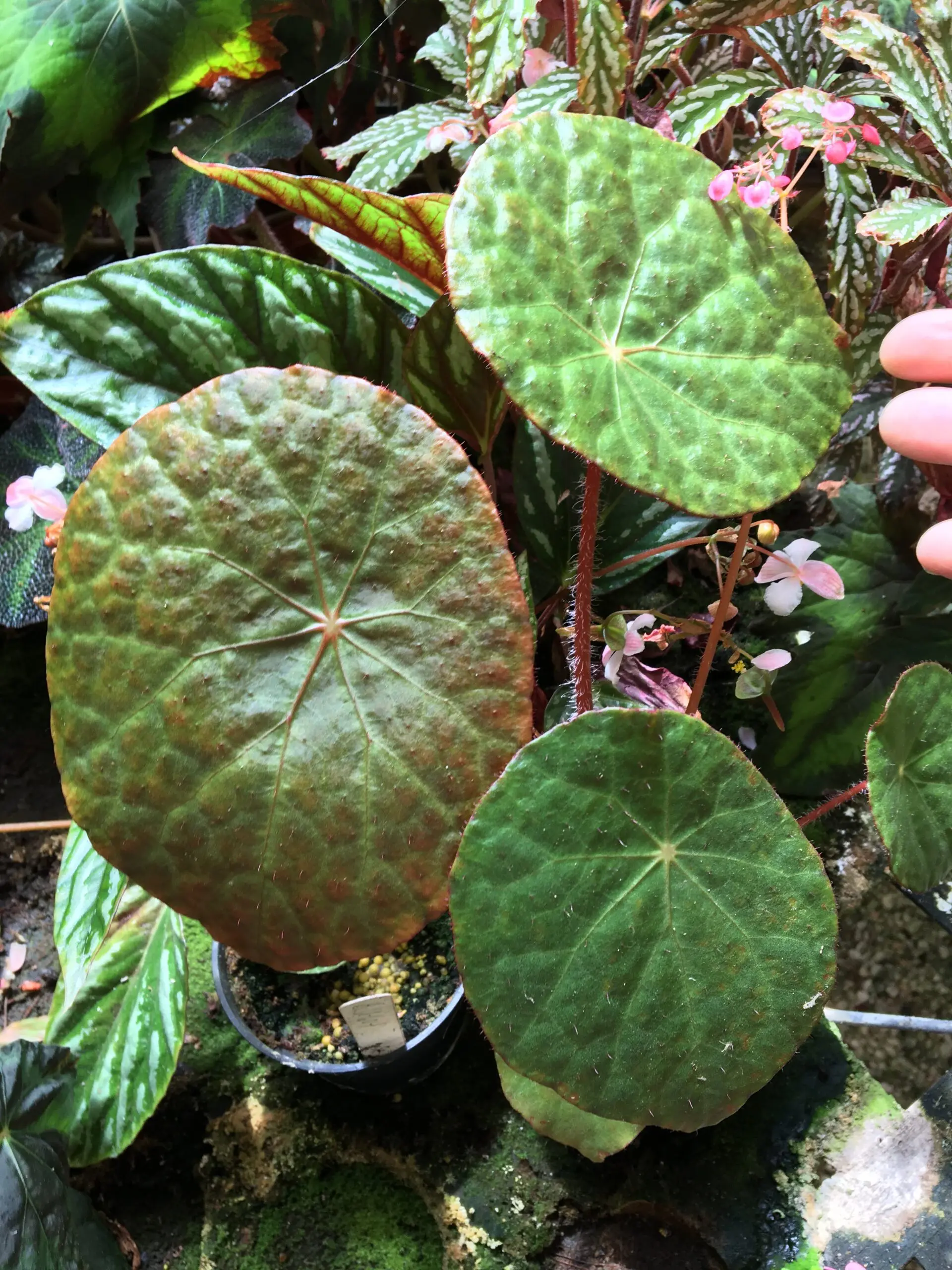They’re called “rhizomatous,” but many are easier to grow than the word is to pronounce (rye-ZOMM-us-tuss). The name means simply that these begonias grow from a modified stem called a rhizome (RYE-zome). Leaves emerge from the rhizome, forming a more or less ball-shaped plant, a virtual mound of leaves, some patterned with spots and blotches.
The rhizome stores water and nutrients like a miniature canteen, making it possible for the plant to survive some neglect, irregular watering, and temperature variation. That means a rhizomatous Begonia will survive more easily than certain other kinds. You still must provide good care, though, if you want a handsome specimen.
Rhizomatous begonias vary in size from windowsill-sized ones with inch-long leaves to giants requiring planting tubs and a growing space a yard across. They include those with multi-pointed leaves called “star begonias”; a group with heavily textured, colorful leaves known as “distinctive foliage”; the widely available iron cross begonia, B. masoniana; a group with frilled lettuce-like leaves; and the “beefsteak begonia,” B. ‘Erythrophylla’.
Some rhizomatous begonias you may run across include B. acetosa, B. bowerae, B. ‘Bow Nigra’, B. ‘Buttercup’, B. ‘Cleopatra’, B. ‘Crestabruchi’, B. goegoensis, B. ‘Joe Hayden’, B. manicata, B. prismatocarpa, B. rajah, B. ‘Tiger Kitten’, B. ‘Universe’, and B. versicolor.
To grow rhizomatous begonias well, use a shallow pot, preferably clay (but if your water is high in salts, plastic pots may be better), and a standard coarse, fast-draining planting mix. Don’t overwater or overpot — move a plant up to a pot only one size larger at a time and only when the roots have filled the present pot. A shallow, wide bonsai pot works nicely. During spring through fall, the time of active growth, water only when the surface of the soil feels dry to the touch. In winter, when some varieties become dormant (growth stops or slows), water only sparingly until growth resumes.
Except for those with “distinctive foliage,” most rhizomatous begonias are not fussy about humidity. About 50% is sufficient, but lower humidity does little harm. The “distinctive foliage” types require high humidity and often are grown in terrariums and other closed containers for this reason.
Rhizomatous begonias are “cool temperature” plants, doing best in the range of 58 to 72 degrees F. In mild winter areas, they may remain outdoors year-round as long as they don’t freeze. In all, they are extremely adaptable.
A “complete” fertilizer (one that contains all three of the main ingredients, nitrogen, phosphorus, and potassium) should be applied according to label directions unless the plant is in dormancy. During dormancy, don’t feed at all. You can tell the percentage of each ingredient by checking the formula (such as 15-30-15) on the label.
These begonias do not attract many insects or develop many diseases. Occasionally, you may find mealybugs. For treatment, dip a cotton swab in alcohol and apply to the insect. Many growers feel any apparent ailment should be diagnosed specifically before any toxic chemical is applied — and such chemical used only if a safer measure will not work. Some growers, however, choose a preventive program of frequent chemical spraying.
Rhizomatous begonias grow nicely when given adequate light without strong direct sun. Under a shade structure or a tree is good. A shaded greenhouse or a window free of direct sun also will suffice. You’ll know when light is insufficient because the leaf stems will elongate and the plant will grow lanky. Some varieties perform well outdoors with morning or afternoon sun in mild areas, but too much light will bleach leaves.
Flowers appear in airy, cloud-like clusters on stems well above the foliage, usually late winter through spring. Some plants bloom at other times.
Tip pinching early develops a well-rounded plant. Pruning usually consists of replanting an old plant that is crowding itself. Rhizomes often will grow over the pot edge. This forms a nicely rounded plant and, unless you find it unattractive, need not prompt pruning. Some rhizomes grow upward and may require pruning to keep the plant in bounds. In any case, pruning yields rhizome cuttings which can be rooted in a medium such as sand or perlite to create new plants.





